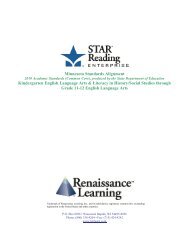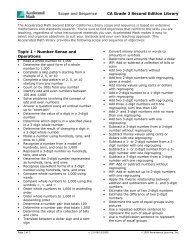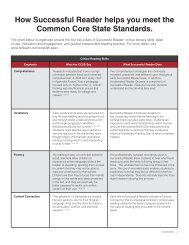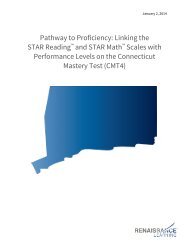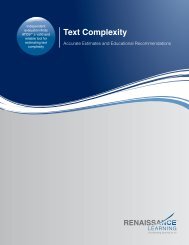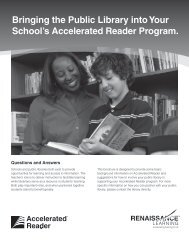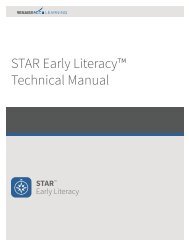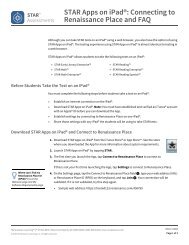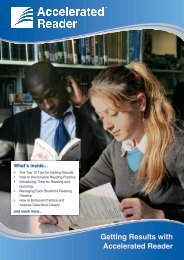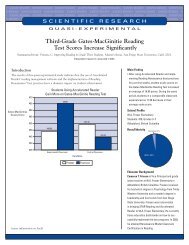Conclusion At the end of the day, users of STAR measures can be confident that every aspect of RTI is easily met by the various reports generated through the STAR assessments. Users of STAR need <strong>to</strong> become comfortable and fluent with the STAR scaled score, which on the surface, can seem a bit abstract compared <strong>to</strong> CBMs direct measures of student performance (i.e., the number of correct sounds, the number of words read per m<strong>in</strong>ute, the number of items correct on a math test). However, the STAR scaled score represents where a student’s skills fall across a longitud<strong>in</strong>al scale spann<strong>in</strong>g the entire school spectrum from k<strong>in</strong>dergarten through grade 12. Placement of students on a longitud<strong>in</strong>al scale is not part of the CBM measurement system. STAR measures offer an important and potentially valuable contribution <strong>to</strong> RTI. Those consider<strong>in</strong>g STAR measures should be confident that the data produced by STAR assessments are accurate, reliable, and valuable for <strong>in</strong>form<strong>in</strong>g decisions that are a part of the RTI process. The STAR measures provide a level of <strong>in</strong>structional plann<strong>in</strong>g <strong>in</strong>formation that exceeds what is produced by CBM alone, a level of support educa<strong>to</strong>rs will certa<strong>in</strong>ly f<strong>in</strong>d useful with<strong>in</strong> the RTI model. STAR offers the added and important advantage of l<strong>in</strong>ks directly <strong>to</strong> <strong>in</strong>structional targets compared <strong>to</strong> CBM. The objective of effective RTI systems is <strong>to</strong> provide <strong>in</strong>structional <strong>in</strong>terventions <strong>to</strong> students who are identified <strong>to</strong> potentially not meet grade-level expectations. Assessment <strong>to</strong>ols are critical <strong>to</strong> RTI. Both STAR and CBM systems measure student performance on the key components of universal screen<strong>in</strong>g and progress moni<strong>to</strong>r<strong>in</strong>g <strong>to</strong> reflect a student’s response <strong>to</strong> <strong>in</strong>tervention. Clearly, RTI does not equal CBM. STAR measures offer an important and potentially valuable contribution <strong>to</strong> RTI. 20
References Abbott, R. D., Bern<strong>in</strong>ger, V. W., & Fayol, M. (2010). Longitud<strong>in</strong>al relationships of levels of language <strong>in</strong> writ<strong>in</strong>g and between writ<strong>in</strong>g and read<strong>in</strong>g <strong>in</strong> grades 1 <strong>to</strong> 7. Journal of Educational Psychology, 102, 281-298. doi: 10.1037/a0019318 Burns, M. K., & Gibbons, K. A. (2008). Implement<strong>in</strong>g <strong>Response</strong>-<strong>to</strong>-<strong>Intervention</strong> <strong>in</strong> Elementary and Secondary Schools. <strong>New</strong> York: Routledge Taylor & Francis Group. Deno, S. L. (1985). Curriculum-based measurement: The emerg<strong>in</strong>g alternative. Exceptional Children, 52, 219-232. Deno, S. L, Mars<strong>to</strong>n, D., T<strong>in</strong>dal, G. (1985-1986). Direct and frequent curriculum-based measurement: An alternative for educational decision mak<strong>in</strong>g. Special Services <strong>in</strong> the Schools, 2, 5-27. doi: 10.1300/J008v02n02_02 Deno, S. L., Mirk<strong>in</strong>, P. K., & Chiang, B. (1982). Identify<strong>in</strong>g valid measures of read<strong>in</strong>g. Exceptional Children, 49, 36-45. Den<strong>to</strong>n, C. A., Barth, A. E., Fletcher, J. M., Wexler, J., Vaughn, S., Cir<strong>in</strong>o, P. T., Roma<strong>in</strong>, M., & Francis, D. J. (2011). The relations among oral and silent read<strong>in</strong>g fluency and comprehension <strong>in</strong> middle school: Implications for identification and <strong>in</strong>struction of students with read<strong>in</strong>g difficulties. Scientific Studies of Read<strong>in</strong>g, 15, 109-135. doi: 10.1080/10888431003623546 Juel, C. (1988). Learn<strong>in</strong>g <strong>to</strong> read and write: A longitud<strong>in</strong>al study of 54 children from first through fourth grades. Journal of Educational Psychology, 80, 437-447. doi: 10.1037/0022-0663.80.4.437 McGl<strong>in</strong>chey, M. T., & Hixon, M. D., (2004). Us<strong>in</strong>g curriculum-based measurement <strong>to</strong> predict performance on state assessments <strong>in</strong> read<strong>in</strong>g. School Psychology Review, 33(2), 193–203. National Center on <strong>Response</strong> <strong>to</strong> <strong>Intervention</strong>. (2010b). Screen<strong>in</strong>g <strong>to</strong>ols chart. Retrieved March 15, 2011, from http://www.rti4success.org/screen<strong>in</strong>gTools Petscher, Y., & Kim, Y. (2011). The utility and accuracy of oral read<strong>in</strong>g fluency score types <strong>in</strong> predict<strong>in</strong>g read<strong>in</strong>g comprehension. Journal of School Psychology, 49, 107-129. doi: 10.1016/j.jsp.2010.09.004 Qu<strong>in</strong>n, P. (2009). Ultimate RTI: Everyth<strong>in</strong>g a teacher needs <strong>to</strong> know <strong>to</strong> implement RTI. Sl<strong>in</strong>ger, WI: Ideas Unlimited Sem<strong>in</strong>ars. Shapiro, E. S., Keller, M. A., Edwards, L., Lutz, G., & H<strong>in</strong>tze, J. M. (2006). General outcome measures and performance on state assessment and standardized tests: Read<strong>in</strong>g and math performance <strong>in</strong> Pennsylvania. Journal of Psychoeducational Assessment, 42(1), 19–35. Shapiro, E. S., Solari, E., & Petscher, Y. (2008). Use of a measure of read<strong>in</strong>g comprehension <strong>to</strong> enhance prediction on the state high stakes assessment. Learn<strong>in</strong>g and Individual Differences, 18, 316-328. doi: 10.1016/j.l<strong>in</strong>dif.2008.03.002 Silberglitt, B., Burns, M. K., Madyun, N. H., & Lail, K. E. (2006). Relationship of read<strong>in</strong>g fluency assessment data with state accountability test scores: A longitud<strong>in</strong>al comparison of grade levels. Psychology <strong>in</strong> the Schools, 43(5), 527-535. doi: 10.1002/pits.20175 Snow, C., Porche, M. V., Tabors, P. O., & Harris, S. R. (2007). Is literacy enough Pathways <strong>to</strong> academic success for adolescents. Baltimore, MD: Paul H. Brookes Publish<strong>in</strong>g. Wright, J. (2007). RTI <strong>to</strong>olkit: A practical guide for schools. Port Chester, NY: Dude Publish<strong>in</strong>g. 21





